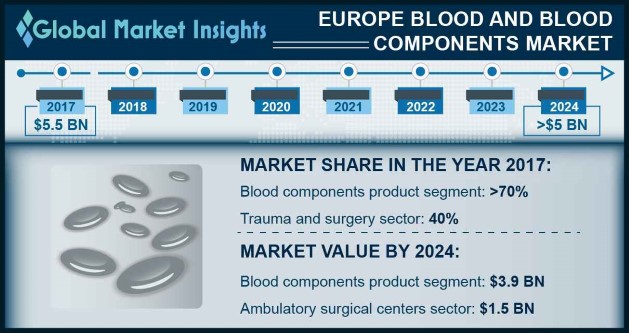Home > Healthcare > Pharmaceuticals > Finished Drug Form > Europe Blood and Blood Components Market
Europe Blood and Blood Components Market Size
- Report ID: GMI3398
- Published Date: Jun 2019
- Report Format: PDF
Europe Blood and Blood Components Market Size
Europe Blood and Blood Components Market size was valued at over USD 5.5 billion in 2017 and is expected to witness -0.7% CAGR from 2018 to 2024.
Substantial number of blood transfusions can be attributed to growing number of infectious diseases such as dengue, rising chronic diseases and bleeding disorders. Cancer patients require blood transfusions owing to anemia caused by the internal bleeding or low blood count due to invasion by the cancerous cells. As per the World Health Organization (WHO), with over 3.7 million new cases and nearly 1.9 million deaths every year, cancer represents the second most important factor for morbidity and mortality in the Europe. Thus, with increasing number of cancer cases, requirement of blood transfusions will gradually increase, thereby affecting Europe blood and blood components market size over the forecast timeframe.
Growing proportion of geriatric population, rising awareness and applications of blood derivatives in the upcoming period should sustain the demand for blood components in the region. According to the European Commission, the old-age dependency ratio in Europe is projected to increase by 21.6%, from 29.6% in 2016 to 51.2% by 2070. Thus, increasing number of elderly patients ultimately increases the need for advanced therapies. In addition, application of blood derivatives including platelet rich plasma in anti-aging therapy will further augment demand for blood components in the foreseeable future.
| Report Attribute | Details |
|---|---|
| Base Year: | 2017 |
| Europe Blood and Blood Components Market Size in 2017: | 5 Billion (USD) |
| Forecast Period: | 2018 to 2024 |
| Forecast Period 2018 to 2024 CAGR: | -0.7% |
| 2024 Value Projection: | 5 Billion (USD) |
| Historical Data for: | 2013 to 2017 |
| No. of Pages: | 103 |
| Tables, Charts & Figures: | 130 |
| Segments covered: | Product, Application, End-Use and Region |
| Growth Drivers: |
|
| Pitfalls & Challenges: |
|
However, high risk of infection from transfusion of blood or blood products may pose a challenge for blood and blood components market growth. Additionally, various initiatives were adopted by the European regulatory bodies to avoid wastage of blood and blood products such as, in some countries, programmes for ‘optimal use of blood’ are implemented during the recent period, to reduce unnecessary infections post blood transfusion as well as avoid wastage of blood. Red blood cells (RBCs) are mainly used in obstetrics, surgery, oncology and haematology care and apparently, due to such initiatives adopted in certain countries the use of RBCs has greatly reduced in the last decade, thus decreasing the market value over the forthcoming years.

